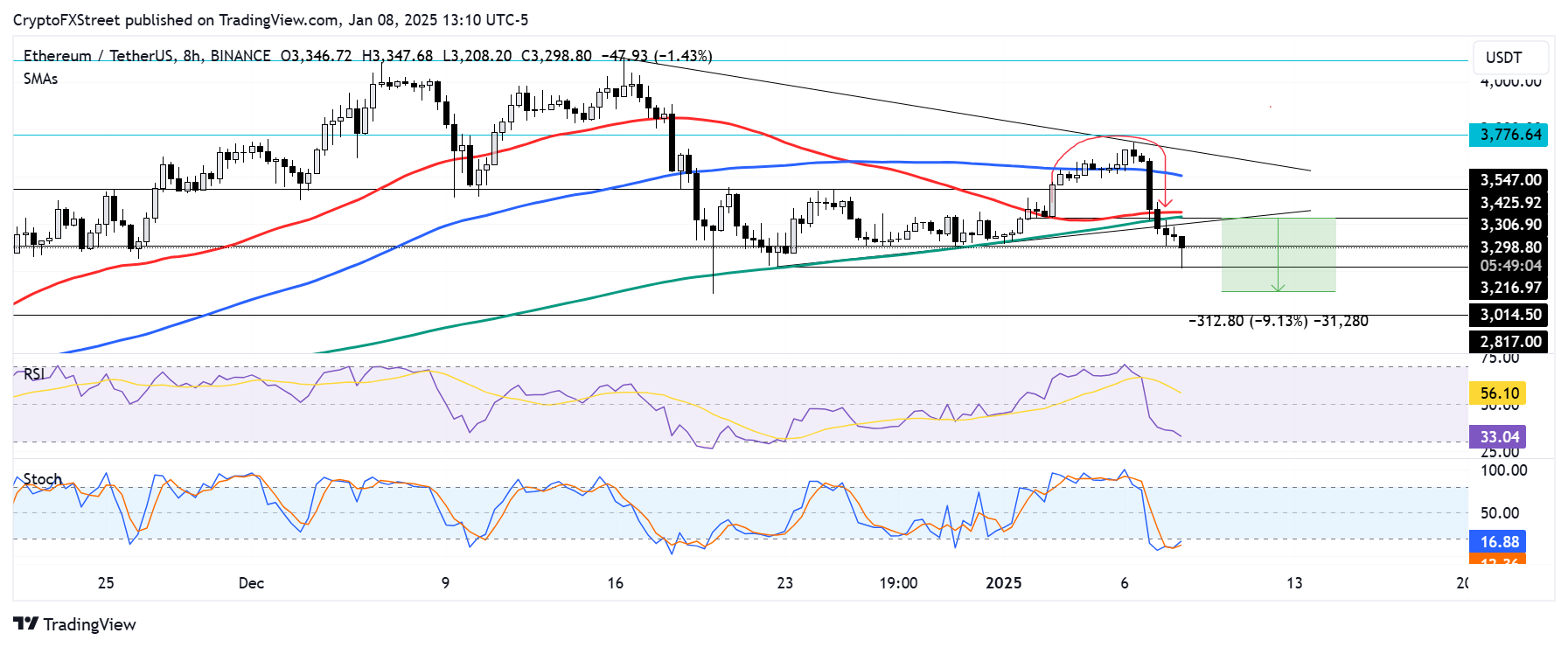Ethereum Price Forecast: ETH could decline to $3,110 despite increased accumulation from whales
Ethereum price today: $3,300
- Ethereum saw a net selling pressure of over 120K ETH sparked by small-scale whales and short-term holders after the market decline.
- Large whales have returned to action, weathering the selling pressure by accumulating 210K ETH.
- Ethereum could stretch its decline to $3,110 to hit the target of a rounding top pattern.
Ethereum (ETH) briefly declined below the $3,300 key level, recording a 4% loss on Wednesday as short-term holders led the selling pressure. If the buy-side pressure of large whales fails to outweigh the bears, the top altcoin could decline to $3,110.
Ethereum whales buy the dip as short-term holders spark selling spree
Following Tuesday's general crypto market decline, investors flooded exchanges with a net inflow of nearly 120,000 ETH worth about $400 million, per CryptoQuant's data.
Net inflows in crypto exchanges signify potential selling activity, while vice versa for outflows.
The Network Realized Profit/Loss metric shows that ETH's 12% decline in the past two days caused most investors to panic into booking losses worth over $50 million.
 [18.27.37, 08 Jan, 2025]-638719586594250074.png)
Ethereum Network Realized Profit/Loss & Supply Distribution. Source: Santiment
Most of the recent selling activity was triggered by investors holding between 1K to 10K ETH, as indicated by the falling blue line in the chart above. These investors depleted their holdings by 110,000 ETH in the past three days.
The spike across the 365-day, 180-day and 90-day Dormant Circulation also indicates that short-term holders were at the forefront of the sell-side pressure.
 [18.28.22, 08 Jan, 2025]-638719587021229440.png)
Ethereum 365D, 180D & 90D Dormant Circulation. Source: Santiment
Dormant Circulation reveals the total amount of distributed coins previously held for a particular timeframe. An increase in this metric signifies distribution, while vice versa for a decline.
The high selling activity pressured the derivatives market, where Ethereum led with over $130 million in long liquidations. The largest single liquidation order was an ETH/USDT position worth $17.74 million, per Coinglass data.
A similar sentiment is visible across Ethereum exchange-traded funds (ETFs), where investors sold $86.8 million worth of their ETH holdings.
However, large whales holding between 10K to 100K ETH have pounced on the price dip, buying 210,000 ETH in the past three days. On the other hand, Ethereum long-term holders (LTH) held still, refusing to be deterred by the market decline.
 [18.25.51, 08 Jan, 2025]-638719587431804257.png)
Ethereum Supply Distribution and 2Y, 3Y & 5Y Dormant Circulation. Source: Santiment
CryptoQuant's Wednesday exchange net flows also indicate a buy-the-dip sentiment, with nearly 200,000 ETH already withdrawn from exchanges in the past few hours.
 - All Exchanges (1)-638719587819010668.png)
Ethereum Exchange Net Flows. Source: CryptoQuant
Ethereum Price Forecast: ETH could decline to $3,110 to hit target of rounding top pattern
Ethereum validated a rounding top pattern on Tuesday following a 10% decline that saw its price breaching the $3,300 key level.

ETH/USDT 8-hour chart
The top altcoin is currently attempting to reclaim a key symmetrical triangle pattern. However, it faces major hurdles at the triangle's lower boundary ascending line and the $3,425 resistance, which is strengthened by the 50-day and 100-day Simple Moving Averages (SMAs).
If ETH continues seeing a rejection at this resistance and the support level at $3,216 fails, it could decline toward $3,110 — a target obtained by measuring the height of the rounding top and projecting it downward
The $3,019 and $3,358 range could provide support to prevent further declines as it represents a historically high demand zone where investors purchased over 10 million ETH.
On the other hand, if ETH overcomes the hurdles stated earlier and reclaims the symmetrical triangle, it faces resistance at the $3,550 level.
The Relative Strength Index (RSI) is below its neutral level, indicating dominant bearish momentum. Meanwhile, the Stochastic Oscillator (Stoch) is in the oversold region, signaling a recovery is imminent.
A daily candlestick close below $2,817 will invalidate the thesis.
Ethereum FAQs
Ethereum is a decentralized open-source blockchain with smart contracts functionality. Its native currency Ether (ETH), is the second-largest cryptocurrency and number one altcoin by market capitalization. The Ethereum network is tailored for building crypto solutions like decentralized finance (DeFi), GameFi, non-fungible tokens (NFTs), decentralized autonomous organizations (DAOs), etc.
Ethereum is a public decentralized blockchain technology, where developers can build and deploy applications that function without the need for a central authority. To make this easier, the network leverages the Solidity programming language and Ethereum virtual machine which helps developers create and launch applications with smart contract functionality.
Smart contracts are publicly verifiable codes that automates agreements between two or more parties. Basically, these codes self-execute encoded actions when predetermined conditions are met.
Staking is a process of earning yield on your idle crypto assets by locking them in a crypto protocol for a specified duration as a means of contributing to its security. Ethereum transitioned from a Proof-of-Work (PoW) to a Proof-of-Stake (PoS) consensus mechanism on September 15, 2022, in an event christened “The Merge.” The Merge was a key part of Ethereum's roadmap to achieve high-level scalability, decentralization and security while remaining sustainable. Unlike PoW, which requires the use of expensive hardware, PoS reduces the barrier of entry for validators by leveraging the use of crypto tokens as the core foundation of its consensus process.
Gas is the unit for measuring transaction fees that users pay for conducting transactions on Ethereum. During periods of network congestion, gas can be extremely high, causing validators to prioritize transactions based on their fees.

